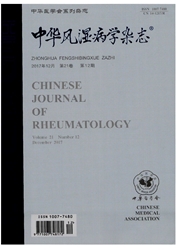

 中文摘要:
中文摘要:
目的分析趋化因子CXCL9基因SNPrs2276886在中国汉族人群中的分布情况以及与系统性红斑狼疮(SLE)遗传易感性的关系。方法①抽提482例SLE患者[其中包括253例狼疮肾炎(LN)患者]外周血DNA,经聚合酶链反应(PCR)扩增后,通过Pyrosequencing法进行等位基因分型。②80例患者同时留取RNA样本并反转录为cDNA,以实时荧光定量PCR方法检测CXCL9基因的表达水平。结果SLE组和LN组等位基因T的频率高于正常对照组(OR分别为1.346和1.347,P〈0.05),Tr基因型的频率也显著高于正常人群(X^2分别是6.397和3.941,P〈0.05)。CXCL9mRNA在rs2276886 TT型个体中的表达(3.9±2.0)高于CC型纯合子(2.5±2.1),P〈0.05。结论证实了中国人群中CXCL9基因SNPrs2276886作为一种遗传因素影响对疾病的易感性,等位基因T对于SLE是一种遗传易感标记。该SNP可能从转录水平上决定了基因的分泌水平,从而参与SLE的发病。
 英文摘要:
英文摘要:
Objective To determine the association of chemokine CXCL9 SNPrs2276886 with systemic lupus erythematosus (SLE) in a case-control study of Chinese population. Methods A total of 482 SLE patients (including 253 patients with lupus nephritis) were compared with 216 control subjects. DNA of peripheral blood were extracted and CXCL9 SNPrs 2276886 in intron 1 were genotyped by pyrosequencing methods. In addition, total RNA of 80 SLE patients was extracted and transcribed into cDNA. Sybr green dye based real-time quantitative PCR method was used to compare the expression levels (indicated as-AACt value) of CXCL9. Results Frequencies of the T allele were significantly higher in patients with SLE (OR 1.346, P〈0.05) and lupus nephritis (OR 1.347, P〈0.05). And the TT genotype also showed significant association with SLE (X^2=6.397, P〈0.05) and lupus nephritis (X^2=3.941, P〈0.05). The expression of CXCL9 mRNA in genotype TT group was 3.9±2.0, higher than 2.5±2.1 in genotype CC group, P〈0.05. Conclusion The T allele of CXCL9 SNPrs2276886 is associated with increased SLE risk. This allele can act as a hereditary label of SLE. This gene polymorphism loci may influence mRNA expression and implicate the pathogenesis of systemic lupus erythematosus.
 同期刊论文项目
同期刊论文项目
 同项目期刊论文
同项目期刊论文
 期刊信息
期刊信息
